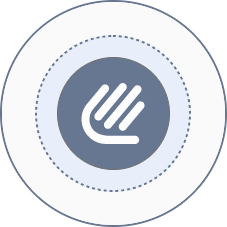
HIGH FIVES
Crowdsourced peer recognition & praise drives motivation & engagement.
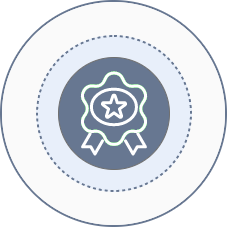
RECOGNITION BADGES
Create a culture of appreciation that makes recognition fun and meaningful.
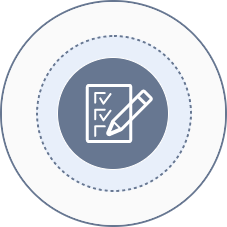
SURVEYS
Pulse, Polls, and eNPS provide a consistent measurement of employee engagement.
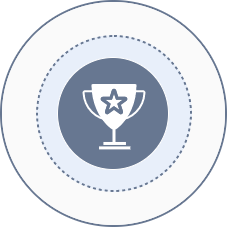
REWARDS
Boost employee morale, motivation, and performance by rewarding goal completion.

High Fives
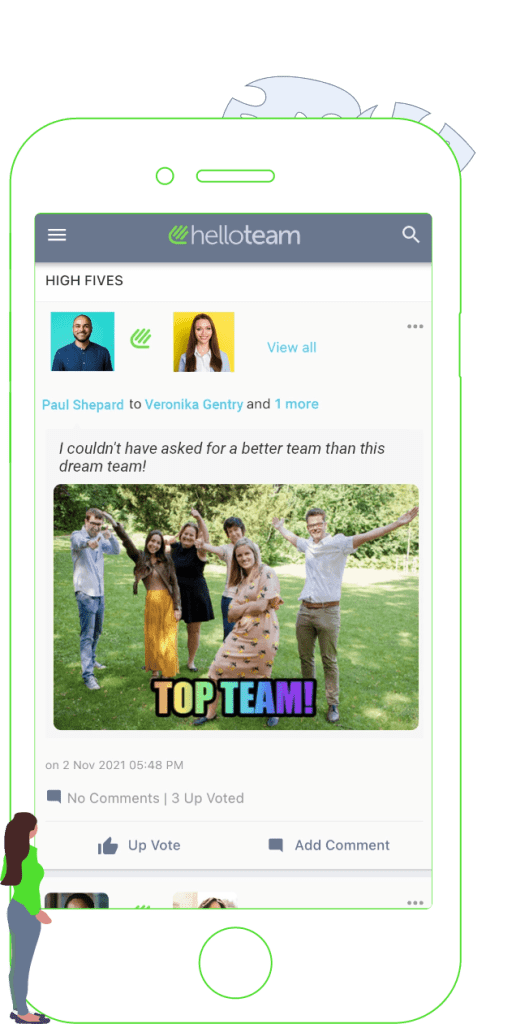
High Fives - Crowdsourced Peer Recognition
The High Five is a staple of the HelloTeam platform that motivates your team and builds a culture of recognition. Give anyone a virtual High Five when you feel they’ve gone above and beyond, with a note attached letting them know of your appreciation.
Fast, Easy, Anywhere, Any Time
Let any teammate know you value their contribution with the click of the High Five button, right from your Dashboard or the HelloTeam mobile app.
Get Noticed and Notified
When you get a High Five, your recognition will be visible to everyone right on the Hello Team dashboard, and you’ll be notified via email, Slack, MS Teams or your mobile app.
Know Who’s Engaged
Not only can you see who is being recognized and appreciated, but managers can also get reports on who’s consistently giving and getting recognition.
Recognition Badges
Recognition Badges - Show off their achievements
Set a dynamic culture of appreciation that makes recognition fun and meaningful. Celebrate exemplary behaviors publicly, and make that moment a target for your entire workforce to aspire to reach.
Customizable Badges
Bring your creativity out by creating your own Badges to be given out to team members that reach a certain goal or exemplify an exceptional trait. Anyone can collect a series of badges and display them on their profile, continuing a culture of appreciation that makes recognition fun and meaningful.
QUICK START – Choose from our predefined badges to begin right away.
ASSIGN – Award badges to the employees to boost their performance and engagement.
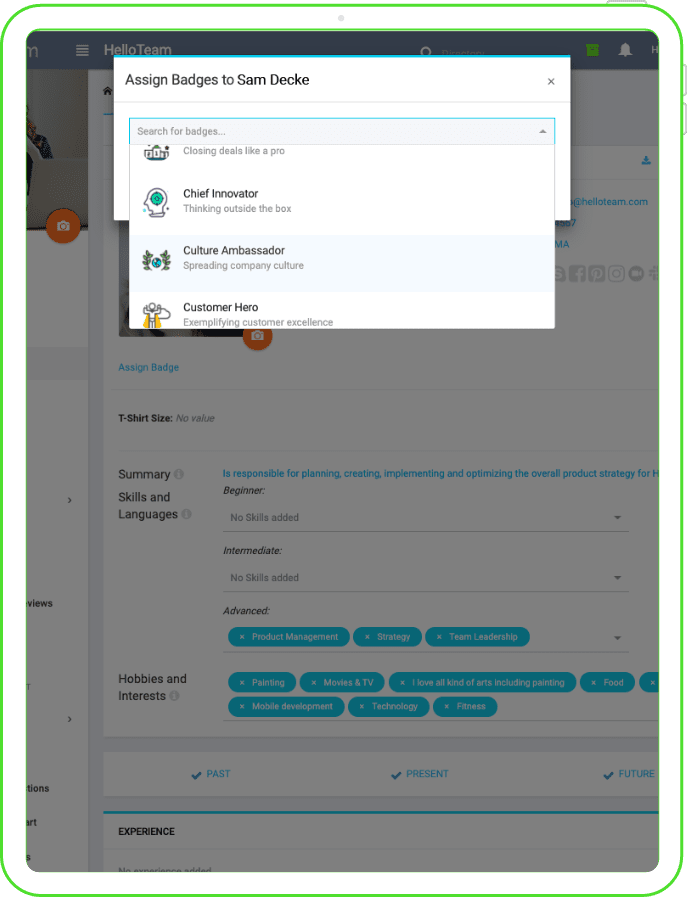

Recognition Badges - Show off their achievements
Set a dynamic culture of appreciation that makes recognition fun and meaningful. Celebrate exemplary behaviors publicly for your entire workforce to aspire to.
Customizable Badges
Bring your creativity out by creating your own Badges to be given out to team members that reach a certain goal or exemplify an exceptional trait. Anyone can collect a series of badges and display them on their profile, continuing a culture of appreciation that makes recognition fun and meaningful.
Surveys
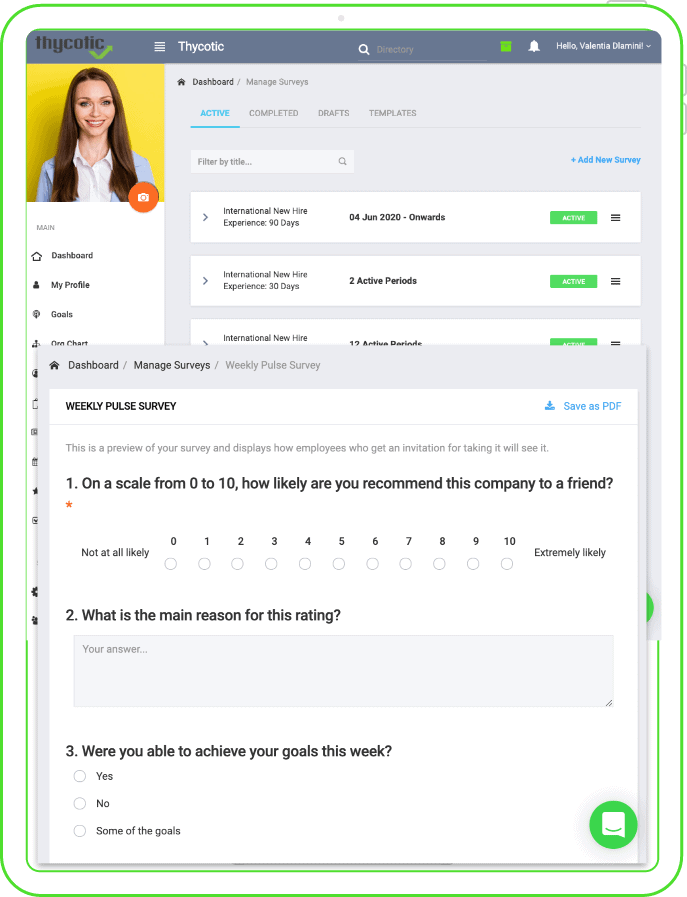
Surveys - Listen and Act
HelloTeam provides you with out-of-the-box culture and engagement surveys, as well as the ability to create your own customized surveys.
Create multiple survey question types (scaled, multiple choice, open ended, etc), collect anonymous feedback and more…
Surveys give your teams a voice
Whether exploring input on a complex business decision or just asking about something casual, HelloTeam’s survey tool lets you communicate with your employees more creatively than ever with six different types of polling options.
Create a culture advantage
Amplify your organization’s culture and align it with employee values to drive employee engagement, retention, happiness and productivity – making your company’s culture a powerful and unique competitive advantage.
Pulse Surveys & Polls
With the aggregation of countless opinions from your staff, you will have an accurate finger on the pulse of your team and the direction they’re headed
Active Alignment
Move the needle for your organization by using feedback to align your team with tangible business goals and organizational values.
eNPS
Earn a positive Employee Net Promoter Score by giving your employees a louder voice than they’ve had anywhere else.
Rewards
Expand Recognition with Redeemable Rewards Programs
More Than High Fives
With the HelloTeam platform, you have the option of integrating Divvy Rewards, a program that accrues rewards points based on High Fives your team has earned.
Get Points
Producing exceptional work can earn you recognition, High Fives, and a collection of points that build towards a reward.
Redeem Rewards
Once a certain number of points are reached, you can redeem a reward – perhaps something voted upon through the Survey module.
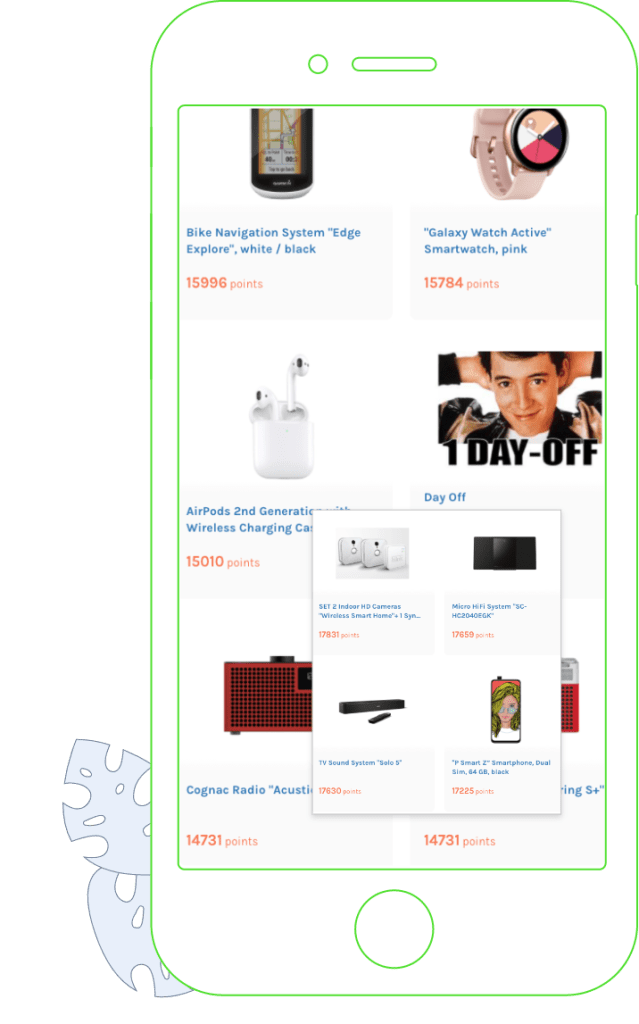
What is Employee Engagement?
Employee Engagement is a term that’s frequently used, but infrequently defined. Is it the extent to which a worker enjoys doing their job, or is it the commitment they have to excelling at their job? Or is it just their absenteeism rate? In reality, it’s everything in that spectrum.
Employee Engagement is the level at which employees are enthusiastic about, connected to, and involved in the success of their organization.
It is a fact: The higher the level of engagement, the better the performance of the company. When an employee is engaged and inspired, they are 125% more productive than an employee who is merely satisfied, per Bain and Company. The organizations with a high percentage of engaged employees outperform their competitors in critical areas of profitability, productivity and customer satisfaction.
Employees who are passionate about their organizations, though, are few and far between. An alarming 18 percent of all employees in the United States are actively disengaged; they do not generate more than what’s considered “good enough” or they undermine their organizations altogether. The economic impact of such disengagement is a staggering $550 billion a year, according to Gallup.
It’s the most essential element of a productive workforce, and it’s also one of the trickiest to implement. The fact of the matter is employee engagement is impossible to force, and without engagement, most long-term corporate initiatives are doomed. This is an existential matter for a company, not a mere HR fad. Businesses today are rushing to reimagine how they acquire, manage, and develop teams, regardless of the company’s size and stage in development.
To foster an environment of engagement, organizations need systems that can help promote and support one. Building a truly engaged workforce is a long-term journey. If you are serious about engagement, buckle up for a long ride. In the end, the rewards will be plentiful. Let’s look at some of the key drivers of employee engagement, each bringing you closer to launching a structured employee engagement program and achieving the ultimate goal of creating a competitive advantage with an engaged workforce.
Communication Done Right
Engagement means passion – but how do you reach into your employees’ hearts and minds? How do you pull the discretionary effort out of them? Start by developing the right communication strategy. The launch of a structured engagement program should be thoroughly planned and continuously communicated throughout the company, setting the stage for future success. Generate more excitement and buy-in from your team by shining a spotlight on what’s to come. A letter from the CEO expressing personal commitment to the initiative is a great way to start.
If you already have a company portal where you post news and company updates, consider it a perfect platform for such communication. The CEO and Senior Leadership Team should champion the initiative while local managers should act as partners and owners of the program on the ground.
Get the word out by promoting the program at the all-hands meetings, asking your team leaders to discuss it with their respective teams, and putting up promotional signage around the office as you prepare to roll it out. Don’t forget to make the engagement program fun! Employees get excited about things that emphasize the fun factor. Encourage your teams to brainstorm unique ideas that will work with your company’s culture, and gather results via a simple survey.
The reward possibilities are endless. It’s a great idea to let your teams brainstorm some fun ideas to get them to instantly feel like part of the initiative. A water balloon battle on a Friday afternoon, a movie night, a company picnic with s’mores or a game night with pizza and cheer, or anything else that their hearts desire. Engaging your team outside of the office will help engage them in the office.
Keep employees updated on the status of the program and showcase your top performers. Use weekly and monthly digest emails to summarize all achievements and goals hit. The key to the program’s overall success: communicate more, keep it current, and stay on top of it by acting promptly on the findings. Communication is one of the most vital types of employee engagement – there are too many reasons to master it.
Implementing a Culture of Recognition
There are actually two elements to developing a culture of recognition. There’s the type of recognition everyone thinks of primarily, which is the giving of rewards and bonuses to top performers. The other half, however, is just as vital – recognizing your employees as people.
Workers begin to care when they feel the company cares for them. Get to know your team members as individuals and give them an opportunity to share what they are passionate about outside of work. Learn about their hobbies and interests, and use this information when setting up your rewards & recognition program. As humans, we tend to be quicker to identify and address issues than acknowledge excellence, which is a vice great leadership needs to beat. Recognize excellence first! The right recognition program is a secret weapon for boosting your team’s loyalty and employee engagement.
Devote extra energy to creating systematic ways to praise members of your teams for good performance. When employees feel emotionally connected to their team and the goals of the organization, they are more likely to go the extra mile. Set a dynamic culture of appreciation that makes recognition fun and meaningful, and celebrate exemplary behaviors publicly for your entire workforce to aspire to.
Some of our best ideas for employee engagement activities are –
- Giving your employees a virtual high-five to recognize their contributions in real time
- Celebrating top employees with an Employee of the Month Award
- Posting a fun badge on the employee’s company profile highlighting recent accomplishments
- Wishing your employees a happy birthday individually
- Introducing a special award recognizing discretionary effort
- Welcoming new hires to the team and introduce them to the company
- Congratulating employees on reaching a professional milestone or recent promotion
- Recognizing and encouraging innovation.
These public signs of appreciation will be some of your biggest drivers of employee engagement and a culture of recognition.
Hiring for the 360° Fit
The negative impact of employee turnover and the positive value of employee retention cannot be understated. That’s why we’ll state it: per industry expert Josh Bersin, the cost of replacing a worker can be an enormous 1.5x their salary.
When you think of ways to boost employee retention, the obvious ones come to mind: good pay, plentiful benefits, and a healthy culture. One more element that’s crucial to remember, though, is the 360° fit – when people themselves match the jobs they work.
Workers who fit their jobs well and enjoy the environment in which they work are more likely to stay committed to them. We tend to receive more satisfaction from jobs that match not only our skills but also interests and personality traits. The process by which we match candidates is the most critical (and controllable) part in developing a well-functioning team. In fact, the #1 reason executives stay at their positions is because of “good job fit” – this applies to the rest of their team as well.
Although the right skillset may seem like the most important factor in determining a good fit, it’s actually not the case. Skills can be acquired, but personalities cannot.
When making hiring decisions or determining optimal internal alignment, companies are beginning to assign equal weight to these three matches:
Technical Competencies (skills match)
Attitudes (organizational match)
Interests/Personality Traits/Cognitive Ability (job match)
If any are misaligned, the employee’s long-term outlook with the company becomes hazy at best. It is unrealistic to expect continued performance from someone whose interests and personality traits are mismatched with the job specifications, even though technical competence may appear on point. That’s how you lose employee engagement with your most talented workers.
If misalignment is not recognized and corrected, the employee is unlikely to perform up to par. They may eventually become disengaged, bored, or frustrated, possibly even leaving in pursuit of a better alignment altogether. Companies are beginning to look at new hires and internal mobility through a 360° lens, bringing those three matches to the forefront. Asking if the candidate has the necessary skillset for a job is becoming equally as important as determining if the job is the right fit for the candidate.
When it comes to current employees, structured training can have a positive impact on the development of skills if you know which skills need to be developed. The difficulty arises when training is introduced via a blanket approach, without consideration of job match or without proper knowledge of the current skills the employee already possesses. It can be frustrating for the employee – and expensive for the company – to engage in training for a skill the employee may already have expertise in.
Making the right hiring decisions and determining optimal internal alignment is really about making great 360° matches — finding the perfect mix of attitude, interests and technical ability in relation to a role. New technology, like HelloTeam’s platform for comprehensive employee engagement and talent management, can offer instant insight into the skills, interests, professional aspirations and job alignment of your teams to help avoid such dilemmas. Hire, promote and align employees with the organizational skills, and job match in mind.
Employee Engagement: Know Where You Stand
There is a distinct correlation between a culture of engagement and a company’s performance.
According to a Gallup poll of almost 50,000 workplaces, those with the highest levels of employee engagement outperformed others in a number of critical areas.
An engaged culture tends to bring greater productivity, higher customer satisfaction levels, less absenteeism & employee turnover, more unsolicited employment applications, and a greater share price increase. Knowing the correlation between engagement and performance, businesses should act promptly if they want to boost their output and gain a competitive edge. You can’t design and implement an employee engagement strategy, though, without knowing where you stand first. When faced with subpar results, take the time to survey your employees before selecting a new option to increase engagement.
You might be surprised at what you discover. Creating a culture of continuous feedback will ensure team members feel heard, recognized and valued. Connecting with your employees beyond the annual performance reviews and acting on their feedback will transform them into advocates for your business.
Before rolling out your employee engagement program, make sure to assess your team’s pre-launch engagement levels to establish a baseline. You will later measure the impact of the initiative against it. After launching the program, continuously measure and adjust the parameters while comparing them against that baseline.
Measuring the impact of employee engagement is relatively simple, reliable (when done consistently) and it doesn’t take more than a few minutes of your team’s time via a pulse Engagement Survey. As you track the aggregate engagement score over time, look for deviations and sudden dips. Check the score’s average variation to see if you are doing better or worse compared to the average. It’s that simple: instant insights, timely action.
Open up a conversation with your teams, uncover hidden issues, and address them before they start affecting your business outcomes.
An Investment that Always Pays Off
No matter how good your product is, or how solid your business strategy appears to be, you need a great team to design the product, continuously develop it, aggressively sell it, and deliver exceptional customer service for repeat business.
Your team is an indisputable driver of your company’s long-term success and your true competitive advantage. Your people will determine how far you go, how fast you grow, and how successful you become. They will make the difference between surviving and thriving.
Invest in your people. As employee engagement begins to grow and become part of the heartbeat of your company, the positive impact will be significant.
If your organization is currently exploring comprehensive employee engagement software that integrates seamlessly with other HR tools, helps align company goals, offers structured recognition programs, and helps your teams stay connected, take a look at HelloTeam. It just might be the last such platform you’ll need to look at.
For even more engagement tips, check out our article here – as well as our whole library of articles here. If you want to see how HelloTeam’s platform can help you attain a high level of employee engagement, schedule a demo!
